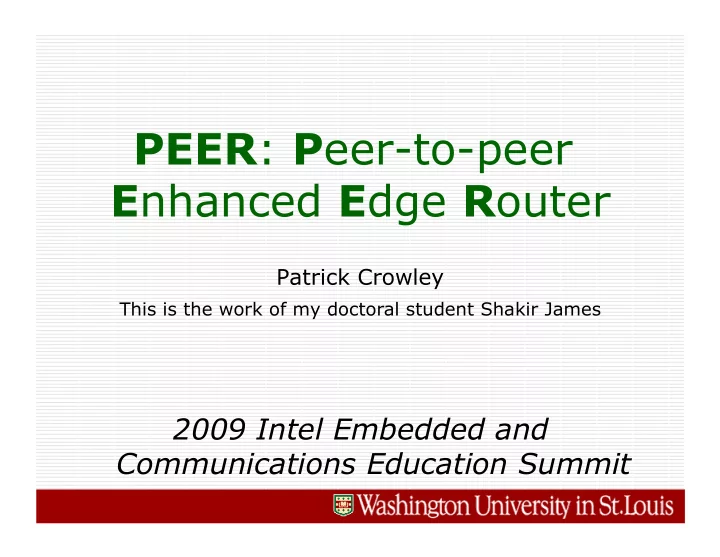

PEER : P eer-to-peer E nhanced E dge R outer Patrick Crowley This is the work of my doctoral student Shakir James 2009 Intel Embedded and Communications Education Summit
P2P: Two Points of View A user’s point of view Support many applications Offer “inexpensive” scalability Recover quickly from failures • Image from talk "P2P: An ISP’s Point of View," by Pablo Rodriguez An ISP’s point of view Route traffic over costly transit links Increase broadband customers , but Surge in traffic ≠ surge in $$$ 2 - Patrick Crowley – Feb 2009
The Problem Duality of P2P Cheap for content providers, but Expensive for ISPs “Cat and mouse” game 1. ISPs: Install traffic-shaping devices 2. P2P : Obfuscate traffic 3. Repeat until… No end in sight! FCC forced ISPs to (temporarily) capitulate Damaged relationship in long-term 3 - Patrick Crowley – Feb 2009
Our Goals Build a network device that Controls costs for the ISP, and Maintains good performance for end-users Show that ISPs can take unilateral action to Foster a sustainable co-existence with P2P Take the first step in fixing relationship Two issues to resolve Illegal content? DMCA “Safe Harbor” a la YouTube How does P2P increase costs for ISPs? 4 - Patrick Crowley – Feb 2009
ISP Economics Client-server economics Internet server Transit ISP ISP transit • $$ • $$ • $$ • $$ link Access ISP ISP ISP client 5 - Patrick Crowley – Feb 2009
ISP Economics P2P economics Internet peer Transit ISP ISP transit ISP-local • $$ • $$ • $$ • $$ link peer Bob Access ISP ISP ISP peer 6 - Patrick Crowley – Feb 2009
BitTorrent Operation • GradsGoneWild.torrent new peer web server seeder tracker leecher • GradsGoneWild.xvid • Swarm 7 - Patrick Crowley – Feb 2009
PEER - 1 P 2P E nhanced E dge R outer Reduces costly, transit traffic Maintains client performance ISPs install PEER alongside edge routers to Exploit existing locality within its network Reply to tracker queries with only local peers PEER works on control traffic by Detect peer-to-tracker query messages Extract metadata from messages Respond to peer with a list of only local peers 8 - Patrick Crowley – Feb 2009
PEER - 2 First-reply policy Transit ISP $$ $$ Access ISP ISP Bob PEER installed 9 - Patrick Crowley – Feb 2009
PEER - 3 detect control extract construct send reply or messages metadata response response forward forward ? incoming message packets • Oracle • . • . • Parser • Filter • . • Proxy Cache 10 - Patrick Crowley – Feb 2009
Evaluation -1 Prototype implementation Use programmable routers Deploy on the Open Network Lab (ONL) as a plugin Goal Compare transit traffic with PEER and without Metrics Upstream/downstream utilization User download time Flash-crowd workload 11 - Patrick Crowley – Feb 2009
Evaluation -2 Factors and their levels in our experimental design Factors Level -1 Level 1 Tracker, choice of Application PEER Number of leechers 20 200 Degree of locality Low High Peer behavior Disconnect immediately Stay connected File size 10 MB 100 MB 1 st seeder location External Local 2 6 - 2 fractional factorial design 16 instead of 64 experiments – saves time! 12 - Patrick Crowley – Feb 2009
Evaluation -3 Effect % variation (var) explained Upstream Downstream Download time Tracker 7.91 8.39 0.00 No. of leechers 59.99 32.92 3.05 Deg. of locality 5.28 0.31 0.00 Peer behavior 1.98 1.52 0.83 File size 1.24 9.88 94.97 1 st seed location 0.23 11.62 0.00 Tracker & locality 7.36 1.12 0.03 No. of leechers account for majority of For upstream, the tracker, degree of locality For downstream, the initial location of the Download time: 95% of var in is due to file size, and the tracker is responsible for 0%. upstream and downstream utilization. and the interaction between them are seeder and interaction between the tracker and no. of leechers (10.03, not shown). important. 13 - Patrick Crowley – Feb 2009
Evaluation -4 perfect localization 14 - Patrick Crowley – Feb 2009
Related Work ISP-dependent: controlled by ISPs Traffic-shaping devices Caching content Developer-dependent Biased-neighbor selection Network coordinates Co-operative ISP-managed “tracker” service 15 - Patrick Crowley – Feb 2009
Concluding Remarks PEER is a network device that Improves P2P network utilization, and Maintains client performance It works across the board and out of the box! Next steps… Explore other response policies Deploy PEER on university network to address recent complaint about excess P2P usage, albeit all legal. Implementations on Atom, Tolopai 16 - Patrick Crowley – Feb 2009
Thanks for listening! Questions? 17 - Patrick Crowley – Feb 2009
Recommend
More recommend